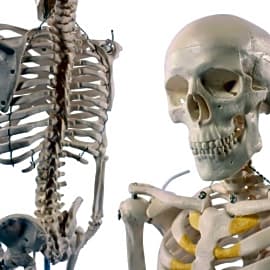The 10 Best Anatomical Skeletons

This wiki has been updated 35 times since it was first published in June of 2016. The human body is one of life’s wonders. Whether you need a thoughtful gift for a cash-strapped medical student or a model for studying in the classroom, these anatomical skeletons offer the opportunity to expand knowledge through hands-on examination. Most of these options can also moonlight as a spooky, lifelike Halloween decoration, and some even have wheeled stands for easy relocation. When users buy our independently chosen editorial choices, we may earn commissions to help fund the Wiki.
Editor's Notes
March 22, 2020:
Upon review, this list did not require any item removals. We did add two items to the Special Honors section: one being a heavy-duty skeleton with removable arms and legs and a skull that can be separated into three pieces, and the other a colorful model best suited for studying the anatomy of muscles and ligaments.
In looking at the Giantex Medical, we noted the ability to bend all the fingers and toes, as well as its high level of detail and movable design. It's an exceptional value, so we upgraded this item.
While the Hbarsci Disarticulated offers more than 200 well-built components and an informational poster of the skeletal system, we discovered that some users are disappointed with a few minor inaccuracies. We dropped this item slightly.
Special Honors
AliMed 70453 This American-made skeleton is a nice choice for hands-on users; its components are made tough plastic cast and natural bone specimens, lending it long-term durability. The skull can be disassembled into three pieces for analysis, and it comes with a rolling stand and dust cover. alimed.com
Southern Biological STH002 From a science education supply company in Australia, this life-size model is ideal for studying the anatomy of muscles and ligaments. The point of origin and point of insertion for each muscle is clearly indicated by color, and it’s made with strong PVC that’s easy to clean. southernbiological.com
A Brief History Of The Skeleton
However, every single one of the gladiators he treated is dead now, so how good of a doctor could he be, really?
It may sound strange to have a history of the skeleton. After all, we've always had them, we've always known where they were, so, end of story, right?
Not so fast. The history of our knowledge of the skeleton can be quite fascinating, and filled with all manner of false starts and mistaken identities.
The early Egyptians are the first people that we know were interested in human anatomy, thanks to medical texts from their time that have survived on papyrus. However, they were mostly concerned with nerves, internal organs, and blood vessels, and seemed to regard the skeleton as merely a shell to protect all the mushy stuff inside.
The Greeks advanced the field of study, adding animal dissection to their curriculum. Even Aristotle was quite interested in anatomy, and his methods included cracking eggs open at differing intervals to track the development of organs, watching octopi mate, and presumably trying to explain to his friends why he was watching octopi mate.
The Greek anatomist Galen took the field much further than his predecessors, in part because his role as physician to gladiators allowed him to see the human skeleton without having to cut up living people to do it. This was important, as the law at that time forbade cutting up cadavers. He was able to draw many correct conclusions, like the fact that the femur is so large because it supports the body's weight. However, every single one of the gladiators he treated is dead now, so how good of a doctor could he be, really?
The study of the skeleton didn't take off again until the Renaissance, when the Belgian Andreas Vesalius obtained permission to vivisect men who had been executed. He was the first to suggest that the skeleton might be easier to study if it were outside of the body, which eventually led to the use of the models that are so commonplace in science classrooms today.
Before that, however, it led to a rise in body snatching. With demand for medical knowledge at a premium, gravediggers would exhume corpses to sell their bones to doctors and universities. This led to many advances, but legislation eventually curbed it, and real skeletons were soon replaced by wooden models, which are the forebears of the plastic versions we have now.
What To Look For In An Anatomical Skeleton
There are many reasons one might be interested in purchasing their own model skeleton, such as studying for medical exams, teaching an anatomy class, or driving in the carpool lane. Regardless of why you want one, however, here are some things to look out for before you make your purchase.
if you expect students to be hands-on with it, make sure it's sturdy and well put-together.
First off, how much detail do you need? Do you need one that shows the location of nerves and arteries, or do you just need the bones? As you might expect, the more in-depth you go, the more you'll end up paying, so figure out what you need before you start shopping.
Also, how up close and personal are people going to get with this thing? if you expect students to be hands-on with it, make sure it's sturdy and well put-together. Not all models are fully flexible, either, so be sure to check on that when doing comparisons. Some have moving parts, as well, like a functioning jaw, which is great if you're working on your ventriloquist act after school.
Many models come on wheels for easy transportation, making it very convenient if you change classrooms a lot, or if you're a chiropractor who needs to drag his skeleton from room to room. Some are even washable, so you can draw on them if you need to really go in-depth with your explanation, or if you've just always wanted to see what a skeleton would look like with a mustache.
Just about any model will get the job done, however, so it's up to you how...bare bones you want to be about it.
Tips For Getting Students Interested In Anatomy
Anatomy is one of those subjects that can be a ton of fun if the teacher knows how to make it engaging. And whether you're trying to get a classroom of unruly students to focus on the skeletal system for a few minutes or you're just trying to force yourself to pay attention before a big test, the right teaching strategy can make all the difference.
You can also trace the location of blood vessels along the bones, if you don't buy a model that already has them marked.
Just like in kindergarten, show and tell is going to be your best friend here. Invite students to compare the model with their own bodies, so that they can see where each bone is located in a way that allows them to relate to the material. You'll find that many people have no idea of where things are on their own spirit vessels, so this is a great opportunity for you to make up fake bones like the "hununculus" and then take a nap at your desk while they look for it.
Repetition is also important, so you can use your skeleton as a sort of modified flash card system. Every day, you can challenge them by pointing at a body part and asking them to name it. This will reinforce what they've already learned without overloading them with new information.
You should supplement any textbook learning with the model, as well. If you're learning about the circulatory system, for example, you can point to where the heart would be in the body, while showing how the rib cage shields it. You can also trace the location of blood vessels along the bones, if you don't buy a model that already has them marked.
Ultimately, you're only as limited as your imagination when it comes to teaching anatomy. Having a skeleton to use for demonstrations is a huge advantage, though, and you'll likely find that your students soak up the information much more easily when they have something to use as a reference.















